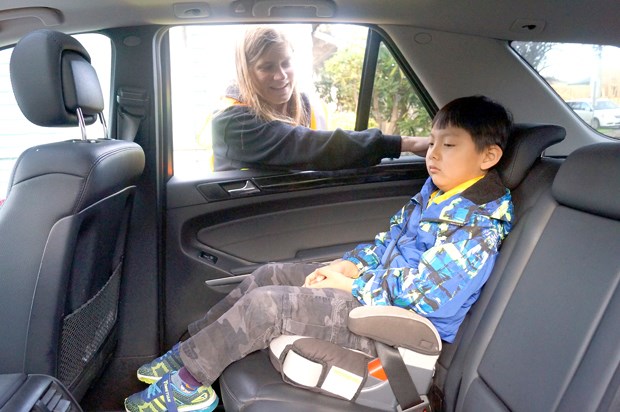Kim Moldowan, a certified children’s restraint technician, has seen every possible wrong way to buckle a child into a car — be it with a child safety seat, a booster seat or a regular seatbelt.
“There’s a 90 per cent failure rate for the installing of car seats or booster seats. It’s really high and it’s due to lack of education,” said Moldowan, who along with volunteers for the Child Passenger Safety Association of Canada, joined Richmond RCMP to perform a surprise safety campaign at Thompson elementary school Wednesday morning.
“We’re trying to get out and volunteer to help parents learn how to install their seats properly,” said Moldowan.
ICBC research indicates that a correctly used child safety seat reduces the risk of fatality by 71 per cent and the risk of serious injury by 67 per cent. Those percentages drop when a child is not harnessed into a car properly.
There are many common errors Moldowan spots on a routine basis. At Thompson, few parents escaped the drop-off round-about without some sort of tip to improve their child’s safety, as police officers showed a strong, yet mild-mannered and helpful presence.
“We’re here as an authority. Our aim here today is education and not so much enforcement,” noted Const. Justin Lee of the RCMP’s Road Safety Unit.
A child found to be improperly restrained can result in a $109 ticket for the driver, said Lee, adding that the worse cases he encounters is when people hold children. Such an infraction can result in a $600 fine.
At Thompson, parent Rachel Che was not alone in getting tips from the volunteer crew.
“The car seat is very important for kids. I didn’t see the head rest wasn’t up,” said Che pointing to the position of her son Lucas’ head, who was in a booster seat.
Moldowan said improper use of booster seats is a common problem, as is improper harnessing and tightness of the restraints and belts for infant car seats.
“There needs to be less than an inch of movement, front to back, side to side in order to keep that seat safe in the event of a crash,” she said.
“If the seat is in the car and buckled up, parents aren’t breaking any laws. What we’re trying to do is teach best practices, to keep children more safe,” added Moldowan.
For instance, she noted it’s best to keep your child rear-facing for as long as possible (up to age 2). She added, if the child is forward facing the head will whip forward in a crash whereas if the child is rear facing the head will experience less movement.
As children grow, seat requirements and restraint tactics change, noted Moldowan, so it’s always best to check in on the rules.
The CPSA hopes to perform more safety blitzes this school year in Richmond, said Moldowan.
For more information go online to Facebook.com/KimsCarSeatHelp.
General Car Seat Tips
• Read the car seat manual.
• Read the car manual.
• Ensure a forward facing seat is top-tethered to an approved anchor.
• Never install a rear-facing seat in front of an active airbag.
• Chest clip at armpit level
• Don’t overdress a child in a car seat. Use blankets.
• Remove potential projectiles from a vehicle.
Source: (CPSA)



.jpg;w=120;h=80;mode=crop)